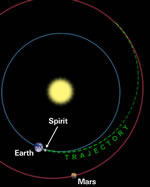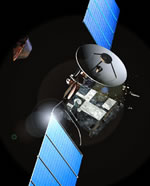
Image credit: NASA
A year’s worth of observations from the Mars Odyssey spacecraft is starting to overturn some older theories about how environmentally active the Red Planet is. Using Odyssey’s Thermal Emission Imaging System (THEMIS), scientists were able to detect geological formations of lava and rock which were deposited under varying environmental condition. One example is kilometre wide sheets of bedrock which are being scoured bare by wind. If Mars were less active, they should be covered in sand and dust.
The first overview analysis of a year’s worth of high-resolution infrared data gathered by the Thermal Emission Imaging System (THEMIS) on NASA’s Mars Odyssey spacecraft is opening Mars to a new kind of detailed geological analysis and revealing a dynamic planet that has experienced dramatic environmental change.
The report by THEMIS’s science team will appear in an upcoming issue of Science and will be released on June 5 in the magazine’s online preview, Science Express.
“THEMIS is creating a set of data that is going to revolutionize our mapping of the planet and our idea of the planet’s geology,” said lead author and THEMIS Principal Investigator Philip Christensen, Korrick Professor of Geological Sciences at Arizona State University. “It will keep Mars scientists busy for the next 20 years trying to understand the processes that have produced this landscape.”
THEMIS is providing planetary geologists with detailed temperature and infrared radiation images of the martian surface. The images reveal geological details that were impossible to detect even with the high-resolution Mars Orbital Camera on NASA’s Mars Global Surveyor and that have 300 times higher resolution than MGS’s Thermal Emission Spectrometer. Among the significant findings noted in the report is the detection of layers in the martian surface that indicate major changes in past environmental conditions.
“With a visible light camera, I can take a picture of a lava flow, but even with the highest resolution cameras that we have today the smallest thing we can see is the size of a bus and in order to do geology I need to have more detail,” said Christensen.
“The camera on Mars Global Surveyor takes exquisite images that show layers, but it doesn’t tell me anything about composition – is it a layer of boulders with a layer of sand on top? I have no way of knowing. With the THEMIS temperature data, I can actually get an idea because the layers vary – and each layer has remarkably different physical properties.”
Daytime and nighttime temperature data can allow scientists to distinguish between solid rock and a variety of loose materials, from boulders to sand and dust. As any beach-goer knows, fine-grained sand heats up more rapidly at the surface than solid stone (which transmits more heat inward) but it also cools off more rapidly at night, when solid materials retain heat.
“We have seen layers, each with dramatically different physical properties, in places like Terra Meridiani,” Christensen said. “Why do the physical properties in the different layers change? They change because the environment in which those rocks were deposited changed.
“It’s very difficult to say exactly what happened in any particular place, but what we’ve found is that in many places on Mars it hasn’t just been the same old thing happening for year after year for billions of years. These data have been so remarkable and so different from all of our previous experience that it has taken time to sift through the images and figure out what we’re seeing.”
Among the details that have stood out so far are kilometer-wide stretches of bare bedrock that Christensen notes were unexpected, given the Mars’ known dustiness. Large areas of exposed rock indicate that strong environmental forces are currently at work, “scouring” from the surface any past sediment as well as any new material that might be falling from the atmosphere.
Also unexpected is the finding that accumulations of loose rock are common on martian hillsides, indicating recent processes of weathering continuing to affect the planet. ” If those rocks had been made a billion years ago, they’d be covered with dust,” Christensen pointed out. “This shows a dynamic Mars – it’s an active place.”
However, despite Odyssey’s past findings of significant martian ice deposits, there are also indications that, in many places on the planet, water may not be one of the active causes behind the observed geological features.
Analyzing the spectra from the ten different bands of infrared light the instrument can detect, the THEMIS team has begun to identify specific mineral deposits, including a significant layer of the mineral olivine near the bottom of a four-and-a-half kilometer deep canyon known as Ganges Chasma. Olivine, Christensen notes, is significant because it decomposes rapidly in the presence of water.
“This gives us an interesting perspective of water on Mars,” he said. “There can’t have been much water – ever — in this place. If there was groundwater present when it was deep within the surface, the olivine would have disappeared. And since the canyon has opened up, if there had ever been water at the surface it would be gone too. This is a very dry place, because it’s been exposed for hundreds of millions of years. We know that some places on Mars have water, but here we see that some really don’t.”
Overall, Christensen notes that the emerging diversity and complexity of the planet point to the likelihood of future surprises and keep enlarging the possibilities for discovery on Mars.
“With Odyssey, we are looking at Mars in its entirety, in context. It’s remarkable how much this has already changed our view of the complexity and richness of the planet. We discovered that it has a really dynamic geologic history. It has far more ice and water than we thought — we’re seeing snow and gullies, layers – and there are also processes involving volcanoes, impact craters and wind. It’s a fascinating place.”
Original Source: NASA News Release





